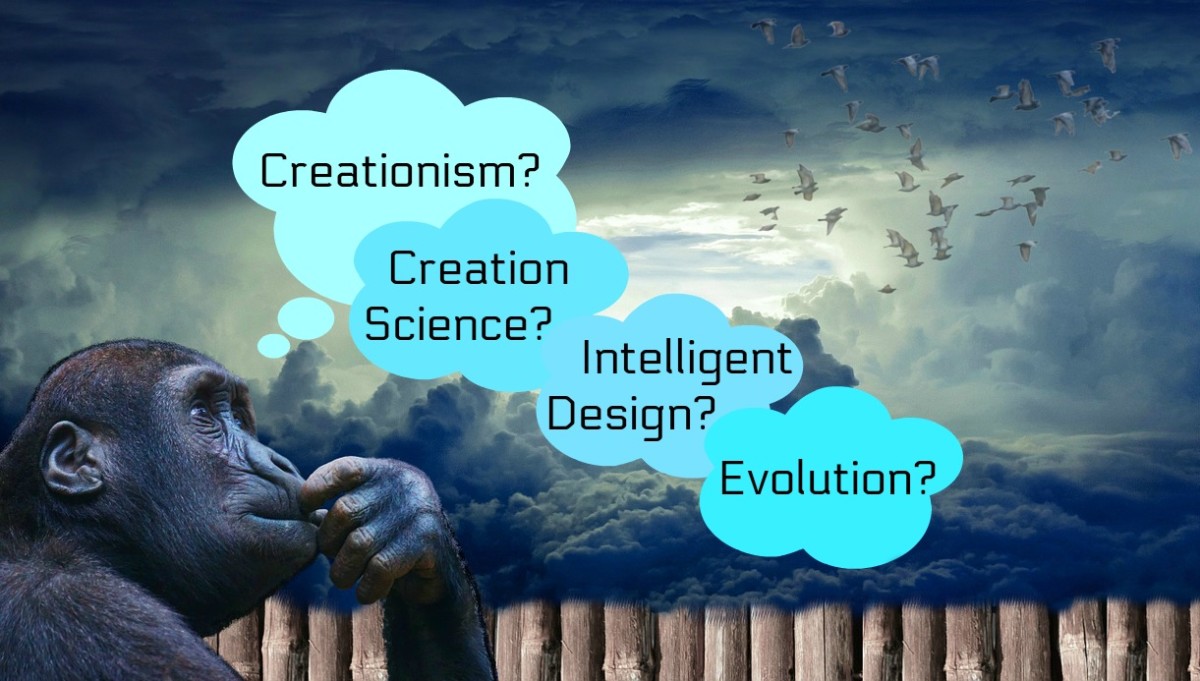Creation Myths (Part 2)

The three main theories of how life came about
Evolution
The evolutionist would say that billions of years ago simple compounds began to form that slowly over millions of years developed and evolved into amino acids that became the building blocks of life here as we know it. About 500 million years ago the first life forms that we would recognize came into being and evolved further until you get to the life forms that we see today. But there are other theories
Intelligent design
This is an interesting concept that some now consider. The idea behind it is that the universe and life itself is too complex to have just evolved. There has to be some form of intelligence behind it, call it God if you will but it's an intelligence that we know almost nothing about except for the clues that have been left us in the way that life has developed. The intelligent design model often uses the same evolutionary timescale and at times the same evolutionary process yet without the idea of chance and adding a 'guiding hand' in the process.
We'll look at the argument for intelligent design later in the hub.
I know what I'm writing here about intelligent design is extremely simplified but it does have some merit.
Creation
This theory takes the Bible at it's face value and accepts the creation narratives as they are. It puts God at the center of creation and he does it not not by natural means but simply by speaking it into existence "And God said" is used many times in the narrative
But is there any proof of any of these?
Why more on this subject?
It was only after I'd finished writing the last hub and published it that I realized that I'd actually left the most important part of the subject unanswered! We'd looked at some of the reasons why the Big Bang and evolution aren't scientifically viable, yet how young is the Earth? Is she as old as the scientists say she is or is she younger and how can we know?
The planet we live on is beautiful and unique. As far as we know it's the only planet in our galaxy that is capable of sustaining life. Situated at just the right distance from our sun to be warm enough for life to flourish yet cool enough for it not to be fried in the heat. It also has just enough water to sustain life on it and just enough oxygen mixed with other essential gases to protect that life from the corrosive effects of that same oxygen. But how long has life been here on Earth?
Depending on whom you talk to you'll get quite a varied answer on the age of the Earth. Anything from a few thousand years old to 4.5 billion years old. Is there any way that we can tell which might be right?
In this hub I want to take a look at the theories as to how old (or young and beautiful) our Earth is and how we might go about finding out her age.
How do we date the Earth?
The main way of dating the earth is by measuring the rate of decay in radioactive isotopes within those rocks and meteorites that have crashed to earth. This method presupposes that the radioactive isotopes decay at a uniform rate over their lifespan. Is this correct?
The main method used in this is called Uranium 238 dating and assumes that the isotope Uranium 238 decays at a uniform rate and is said to have a half life of 4.5 billion years. The system (Discovered by Lord Rutherford) has been used for just over a hundred years and users claim that it is accurate to within 1% so it is reliable.
Unfortunately since the 1970s data has begun to emerge that says a different story! Tests done on various mineral samples from Meteorites all over the globe have found large variations in the ages of the Meteorites that should not have happened if the system was accurate. Some of the Meteorites had large variations within the same Meteorite at the time of testing! Naturally the geological world has kept silent about this as to speak out would threaten one of the building blocks of the argument for an old Earth theory!
What do you think?
How old is the Earth?
What are you on about?
I can hear people screaming this as I sit and write this hub. Truth is until a few weeks ago i would have been one of them so here's a "layman's understanding" of the term.
Every substance in existence is made up of atoms. In each of the atoms you'll find Protons and Neutrons. These live in the nucleus of the atom there are usually an equal number of both but so substances can have slightly more of one than the other (no big deal unless you're a nuclear physicist) around the nucleus race particles called electrons. They're held in orbit (kind of) because the nucleus has a positive electric charge and the electrons are negative charge. With Uranium 238 the nucleus has 92 protons, 146 neutrons (giving 238 parts in the nucleus) and 238 electrons whizzing round it.
The problem is that there are only so many stable elements in existence (81 in total though two more are included in the periodic table despite the fact that they can only be created inside a nuclear reactor and last for nanoseconds!) Uranium isn't a stable element and over time it will slowly lose electrons going through various stages until it literally becomes lead!
The loss of the mass to the atom results in an energy transfer that comes out as radiation and until the stuff becomes stable it's radioactive and not very pleasant for us
Up until recently (and most scientists still believe this) it was thought that it would take 4.5 billion years for half of our Uranium 238 turn into Lead (the half-life) yet It's the most common form of Uranium found in nature! If the Earth is that old then there should be much less of this material than there actually is!
Uranium 238 dating can only be trusted if the following conditions are met
- The system has to be a totally closed system with no possibility of contamination. The only way this can happen is if the specimen is kept in a sealed lead lined container (lead on the outside) for it's entire existence.
- It must have none of it's daughter products. Not just no lead but none of the other thirteen stages it will go through before becoming lead
- The rate of decay must be constant. If for any reason it's exposed to higher levels of radiation from space then the specimen is tainted as the rate of decay is affected.
- Changes in atmosphere affect the radioactivity of minerals
- The Van Allen Belt. Any changes in this belt (a highly radioactive belt encircling the earth 400 miles into space) can greatly affect the materials.
My source for these conditions is the following website
http://evolutionfacts.com/Evolution-handbook/E-H-6a.htm
Just a cursory reading of the criteria tells even the most scientifically illiterate person that they can't and never will be met! In fact not one of the criteria can be met.
This is why I believe that dating of the earliest rocks using this method is flawed.and the earth cannot be as old as evolution says it is. The same goes for the other forms of radio dating (Potassium-Argon)
Potassium-Argon dating has many of the same problems but the half life of 1.25 billion years but the same problems exist. The claim is that because we know how much Argon is in the atmosphere we can compensate for any incidental contamination! Yeah Right
What about the fossil record?
This is a subject that always comes up when discussing creation and evolution and it's really interesting to hear the debates as both sides claim that the fossil record supports their argument!
Evolutionary scientists look to the fossil record to explain how old everything by claiming the age of the fossils is set by the type of rock they are found in. Sometimes they can also use radiometric dating but with sedimentary rock (where you usually find the fossils) you can't as the rock has been laid down over long periods of time as the animal died and settled on the seabed or riverbed. Radiometric dating is recognized as only being effective with igneous rock (that which forms from molten magma) where Sedimentary rock has been worn down by water, washed away and reformed in another place. Carbon 14 only has a half life of 5,700 years and can't be used beyond anything thought to be more than 50,000 years old. Basically an evolutionary scientist would look at the rocks nearby. If there are Igneous rocks then they would claim the age of those rocks as the age of the fossil with the idea that if they say it loud enough or often enough people will believe them and the system has worked a treat for the last hundred years.
The Geologist dates the rocks by the fossils in them (with no evidence except what the Paleontologist says) and the Paleontologist dates the fossils by what the Geologist says is the age of the rock!
The Creationist says "Hang on you've not told me anything that can be proven! Not only that but where are the 'missing links you keep going on about?"
Below is an interesting video of some surprising finds. If you want to see more then by all means go to the following site for the full documentary
https://www.youtube.com/watch?v=7xYyHU5mRFo
It's well worth the watch and kind of puts a spanner in the works of dinosaurs being so old!
Could the fossils be that old? What about these?

Some of the Sciences Evolution ignores
Evolution and it's proponents tell us that theirs is the ONLY scientific theory yet there are a number of sciences that evolution has to either ignore or totally disregard. They are as follows
- Thermodynamics. Only four laws (three and the Zeroth law) and evolution ignores them all simply because if you follow them then the Big Bang can't have happened or any other part of evolution
- Physics. Thermodynamics is a building block of physics. If you ignore one then the other falls too
- Biogenesis. The science that says life can't spring naturally from lifeless objects. The idea of spontaneous generation of life was a common idea from ancient times and held some sway until the nineteenth century when Louis Pasteur demonstrated that it's impossible. Thus was part of his work with microbes that won him the Nobel prize. Evolutionists now dispute this as a science because for their model to work they have to have spontaneous generation of life
These are just three of the sciences that they have to ignore or disregard to believe in evolution something that they never tell the general public. WHY?
Notice something here?
Did you notice that Charlton Heston said that the rocks had been dated at one hundred million years? Yet right next to those dinosaur footprints dated at 100 million years are Human footprints in the same rock laid down at the same time! How can that be? Can Human footprints be that old?
I'm not sure what kind of dating method was used. It wouldn't have been carbon 14 (the most common for animals and Humans) as the half life of carob 14 is only 5,700 years and is never used on something thought to be as old as these. It could have been either Potassium-Argon or Uranium 238 but one thing is clear. Someone got the dates wrong!
The rocks have been dated at twenty times what even evolutionary science says man has been on the earth! Surely getting the dates that far out says something about the lack of accuracy!
Enjoyed this hub?
If you enjoyed the hub or have something to say about the things I've raised then share it below.
If you enjoyed this hub then take a look at some of my other hubs by going to my profile page (Top right and click on my name). You can also share it with Facebook and lets raise awareness of the reality. God did create the world and he loves us enough to want us to know he did.








